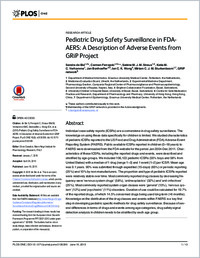Pediatric Drug Safety Surveillance in FDA-AERS: A Description of Adverse Events from GRiP Project.
- de Bie S Department of Medical Informatics, Erasmus University Medical Center, Rotterdam, the Netherlands; Medicines Evaluation Board, Utrecht, the Netherlands.
- Ferrajolo C Department of Medical Informatics, Erasmus University Medical Center, Rotterdam, the Netherlands; Experimental Medicine Department, Pharmacology Section, Campania Regional Center of Pharmacovigilance and Pharmacoepidemiology, Second University of Naples, Naples, Italy.
- Straus SM Department of Medical Informatics, Erasmus University Medical Center, Rotterdam, the Netherlands; Medicines Evaluation Board, Utrecht, the Netherlands.
- Verhamme KM Department of Medical Informatics, Erasmus University Medical Center, Rotterdam, the Netherlands.
- Bonhoeffer J Brighton Collaboration Foundation, Basel, Switzerland; University Children's Hospital Basel, University of Basel, Basel, Switzerland.
- Wong IC Centre for Safe Medication Practice and Research, Department of Pharmacology and Pharmacy, University of Hong Kong, Hong Kong, China.
- Sturkenboom MC Department of Medical Informatics, Erasmus University Medical Center, Rotterdam, the Netherlands; Department of Epidemiology, Erasmus University Medical Center, Rotterdam, the Netherlands.
- 2015-06-20
Published in:
- PloS one. - 2015
Adolescent
Adverse Drug Reaction Reporting Systems
Child
Child, Preschool
Databases, Factual
Drug-Related Side Effects and Adverse Reactions
Humans
Infant
Infant, Newborn
Pharmaceutical Preparations
United States
United States Food and Drug Administration
English
Individual case safety reports (ICSRs) are a cornerstone in drug safety surveillance. The knowledge on using these data specifically for children is limited. We studied characteristics of pediatric ICSRs reported to the US Food and Drug Administration (FDA) Adverse Event Reporting System (FAERS). Public available ICSRs reported in children (0-18 years) to FAERS were downloaded from the FDA-website for the period Jan 2004-Dec 2011. Characteristics of these ICSRs, including the reported drugs and events, were described and stratified by age-groups. We included 106,122 pediatric ICSRs (55% boys and 58% from United States) with a median of 1 drug [range 1-3] and 1 event [1-2] per ICSR. Mean age was 9.1 years. 90% was submitted through expedited (15-days) (65%) or periodic reporting (25%) and 10% by non-manufacturers. The proportion and type of pediatric ICSRs reported were relatively stable over time. Most commonly reported drug classes by decreasing frequency were 'nervous system drugs' (58%), 'antineoplastics' (32%) and 'anti-infectives' (25%). Most commonly reported system organ classes were 'general' (13%), 'nervous system' (12%) and 'psychiatric' (11%) disorders. Duration of use could be calculated for 19.7% of the reported drugs, of which 14.5% concerned drugs being used long-term (>6 months). Knowledge on the distribution of the drug classes and events within FAERS is a key first step in developing pediatric specific methods for drug safety surveillance. Because of several differences in terms of drugs and events among age-categories, drug safety signal detection analysis in children needs to be stratified by each age group.
- Language
-
- English
- Open access status
- gold
- Identifiers
-
- DOI 10.1371/journal.pone.0130399
- PMID 26090678
- Persistent URL
- https://folia.unifr.ch/global/documents/102034
Statistics
Document views: 9
File downloads:
- fulltext.pdf: 0
